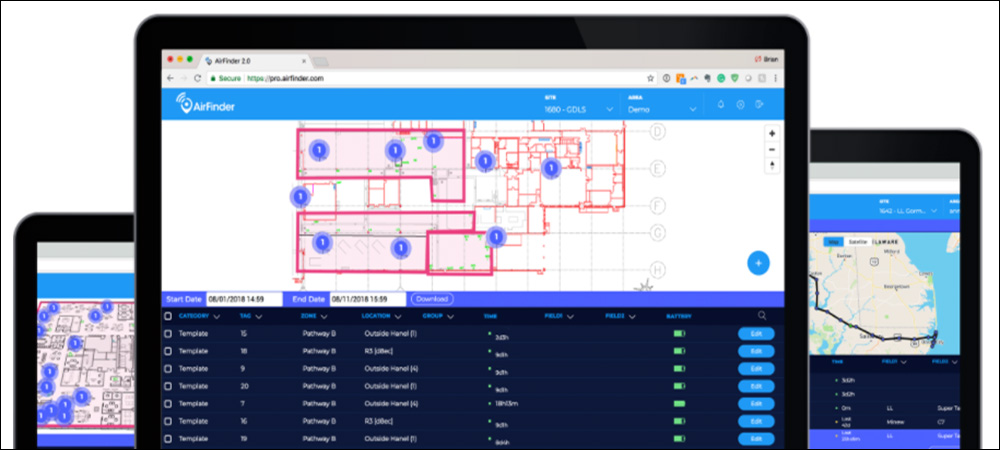Presented here are recent news announcements regarding the following organizations: Zebra Technologies, A2B Tracking, STMicroelectronics, Intel, Murata, Senet, the Industrial Internet Consortium, Link Labs, Semtech and the MXC Foundation.
Zebra Technologies Validates A2B Tracking for Fixed RFID Readers
A2B Tracking has completed Zebra Technologies‘ Validated Program for use with Zebra fixed RFID readers in conjunction with A2B’s RFID Tracking platform. The platform has achieved validation for Zebra’s FX9600, FX7500, ST5500 and SR5502 reader models. The Validated Program enables channel partners to test the interoperability of their software solutions with Zebra mobile computers, scanners, printers and RFID readers to meet user application-specific needs, and to reduce risk and deployment time.
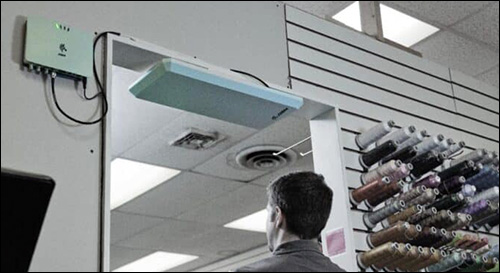 A2B’s RFID Tracking platform has been validated for use with Zebra’s fixed readers, which lets customers and partners know that it was successfully tested, confirming its performance and functionality. Working with Zebra’s engineering teams, A2B tested the platform and validated it for interoperability with the specified reader models.
A2B’s RFID Tracking platform has been validated for use with Zebra’s fixed readers, which lets customers and partners know that it was successfully tested, confirming its performance and functionality. Working with Zebra’s engineering teams, A2B tested the platform and validated it for interoperability with the specified reader models.
The RFID Tracking platform is designed to manage critical asset-tracking applications, such as counting inventory, editing asset details, checking in and out, performing cycle counts and more. A2B Tracking’s technology is a secure cloud-based asset-management system that can be accessed via a desktop browser, a smartphone or a mobile computer connected to the A2B RFID Tracker app. A fixed reader, combined with A2B’s Pro-Locate feature, enables users to search and find assets quickly, the company reports.
STMicroelectronics Works with Intel on MEMS Mirror, Offers New BLE MCU
STMicroelectronics has developed a tiny MEMS mirror with Intel, enabling spatial scanning of an environment. Intel developed a LiDAR system based on this micro-mirror, which provides high-resolution scanning for such industrial applications as robotic arms for bin picking, volumetric measurements, logistics and 3D scanning.
Built into Intel’s RealSense LiDAR Camera L515, the micro-mirror fits the LiDAR camera’s hockey-puck size, as it measures 61 millimeters (2.4 inches) in diameter by 26 millimeters (1 inch) in height. The micro-mirror enables continuous laser scanning across a field of view. In combination with a custom photodiode sensor, the RealSense LiDAR Camera L515 renders a 3D depth map of an entire scene. According to ST, the camera leverages the scanning capabilities of ST’s MEMS to deliver high-resolution depth with no interpolated pixels, the ability to control the field of view, and almost no pixel blur.
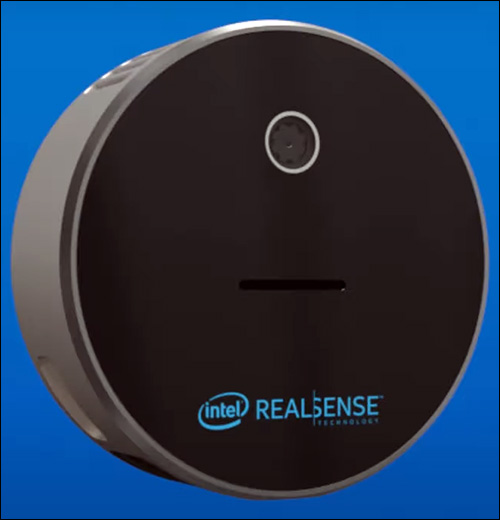 “With 30 frames per second and a field-of-view of 70 degrees by 55 degrees, ST’s second-generation micro-mirror continues to set the bar for 3D scanning and detection applications,” said Benedetto Vigna, the president of STMicroelectronics’ Analog, MEMS and Sensors Group, in a prepared statement. “Continuing the long-term supply relationship for micro-mirrors with Intel demonstrates our never-ending efforts to leverage our long-lasting leadership in MEMS to meet the demanding technical and supply needs of our customers.”
“With 30 frames per second and a field-of-view of 70 degrees by 55 degrees, ST’s second-generation micro-mirror continues to set the bar for 3D scanning and detection applications,” said Benedetto Vigna, the president of STMicroelectronics’ Analog, MEMS and Sensors Group, in a prepared statement. “Continuing the long-term supply relationship for micro-mirrors with Intel demonstrates our never-ending efforts to leverage our long-lasting leadership in MEMS to meet the demanding technical and supply needs of our customers.”
In addition, ST has extended its STM32WB Bluetooth Low Energy (BLE) microcontroller (MCU) offering with several new devices. The dual-core STM32WB15 and STM32WB10 Value Line pair an Arm Cortex-M4 processor to run the main application and a Cortex-M0+ to handle Bluetooth 5.2 connectivity, ensuring real-time performance from each. The radio stage has a 102dBm link budget to ensure reliable connections over long distances, the company reports, and integrates balun circuitry to save board space and reduce the bill of materials.
The devices are designed for cost-sensitive, power-conscious embedded applications, ST explains, including wearables, beacons, smart circuit breakers, trackers, IoT endpoints and industrial automation equipment. A software development kit for each MCU comes with standardized radio protocol stacks and openness to proprietary protocols, with a set of security mechanisms to ensure safe software updates for brand protection and device integrity, as well as Proprietary Code Read-Out Protection to guard intellectual property.
The STM32WB series scales across package variants, offering extended GPIOs and pin-to-pin compatibility between similar packages. Customers can migrate designs between devices to utilize different features and memory densities, leveraging pin-compatibility across packages. The development ecosystem includes STM32Cube certified radio stacks that support various profiles, software expansion packs and sample code, the STM32CubeMX configurator and initialization code generator, the STM32CubeIDE development environment, a STM32CubeMonitor-RF evaluation tool, and associated Nucleo hardware tools.
Murata Teans with Senet on LoRaWAN IoT, Expands Product Portfolio
Senet, a provider of cloud-based software and services platforms designed to enable global connectivity and on-demand network build-outs for the Internet of Things (IoT), has announced a collaboration with Murata to certify operation of the firmware updates over-the-air (FUOTA) capabilities of Murata’s Type 1SJ LoRaWAN modem module with Senet’s LoRaWAN network server.
Through this integration, Senet has certified the secure and reliable remote multicast delivery of firmware images to end devices developed with the Type 1SJ modem module to be compliant with the technical recommendations of the LoRa Alliance, and to operate on the Senet network. This collaborative integration helps future-proof LoRaWAN solution deployments, Senet explains, to ensure that sensor-enabled IoT end devices built using the Murata module will operate on Senet’s IoT network.
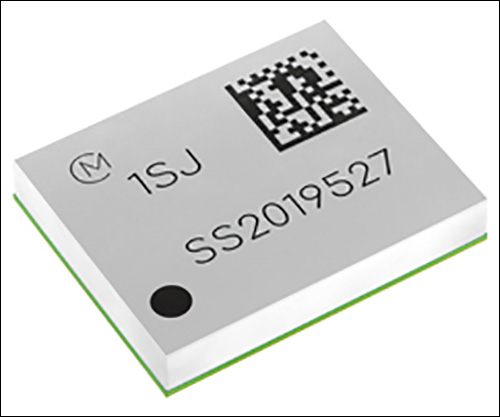 “Murata’s support of LoRaWAN FUOTA and its integration with Senet’s network server expands our ability to deliver efficient, secure and reliable end-device updates,” said Randy Houde, a Senet software architect, in a prepared statement, “providing end customers with a maximum return on investment for IoT applications deployed at mass scale.” The Type 1SJ modem module allows solution developers to design products that meet the requirements of such applications as asset tracking, utilities, agriculture, smart cities, smart buildings, industrial and more.
“Murata’s support of LoRaWAN FUOTA and its integration with Senet’s network server expands our ability to deliver efficient, secure and reliable end-device updates,” said Randy Houde, a Senet software architect, in a prepared statement, “providing end customers with a maximum return on investment for IoT applications deployed at mass scale.” The Type 1SJ modem module allows solution developers to design products that meet the requirements of such applications as asset tracking, utilities, agriculture, smart cities, smart buildings, industrial and more.
“Murata’s Type 1SJ LoRaWAN modem module enables a faster time-to-market and eases design challenges for IoT developers,” added Steve Kim, Murata’s business-development manager for connectivity solutions, in the statement. “Our FUOTA collaboration with Senet proves that the LoRaWAN network server to end-device communication works effectively. The result provides customers with a significant advantage as they can utilize a complete module to shorten end-device development cycle and save costs with a pre-certified module.”
Murata has expanded its Type 1SJ product line with the addition of a new LoRaWAN modem solution. The AT Command controlled modem module measures 10 millimeters by 8 millimeters by 1.6 millimeters (0.4 inch by 0.3 inch by 0.06 inch) and incorporates low-power modes that allow its real-time clock to operate while drawing a typical current of 1.3µA. This current consumption level, the company explains, assures that a single battery can operate for years. Based on Semtech’s SX1262 RF IC, the module comes preloaded with AT Command firmware and a LoRaWAN stack with an AT Command middle layer. The device supports the US915 band in North America, and future versions are intended for the European, Indian, Chinese and Pacific Rim markets.
“The new Type 1SJ LoRaWAN modem module allows designers to develop products that meet the most demanding requirements, especially in areas such as asset tracking, utilities, agriculture, smart cities, smart buildings, industrial and other IoT applications,” Kim said in a separate prepared statement. “By collaborating with Semtech on this offering, we leverage both companies’ leadership and expertise to create the solutions most needed in IoT market.”
Industrial Internet Consortium Publishes IIoT MILS Architecture White Paper
The Industrial Internet Consortium (IIC) has announced its latest white paper, titled “MILS Architectural Approach Supporting Trustworthiness of IIoT Solutions.” The paper describes the MILS architectural approach, a strategy for the construction of systems requiring dependability and high assurance. The paper explains how this approach can help users build trustworthy IIoT systems.
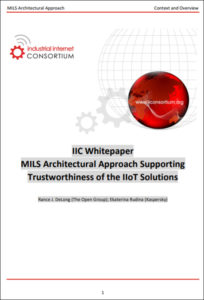 “MILS builds on and extends a long tradition of work on architectural approaches to security, and provides methods and tools to create high-assurance architectures for secure information sharing and dependable systems,” said co-author Rance J. DeLong, a staff scientist at The Open Group, in a prepared statement. “These approaches leverage system architecture to prohibit unauthorized subjects from accessing or modifying sensitive information. A thoughtful architecture also limits damage from a compromised or failed subject.”
“MILS builds on and extends a long tradition of work on architectural approaches to security, and provides methods and tools to create high-assurance architectures for secure information sharing and dependable systems,” said co-author Rance J. DeLong, a staff scientist at The Open Group, in a prepared statement. “These approaches leverage system architecture to prohibit unauthorized subjects from accessing or modifying sensitive information. A thoughtful architecture also limits damage from a compromised or failed subject.”
The acronym “MILS” initially meant “Multiple Independent Levels of Security/Safety,” the organization explains, but is now used as a proper name for an approach that begins with partitioning a system into isolated compartments or security domains. MILS supports scalable, distributed, and heterogeneous environments and dynamically changing configurations, and is intended to enhance the trustworthiness of IIoT systems, including safety, reliability, resilience, security and privacy.
“A key MILS objective is to encourage a competitive commercial marketplace of off-the-shelf, high-assurance components,” added co-author Ekaterina Rudina, the manager of Kaspersky‘s Security Analysis Group, in the statement. “The technologies underlying MILS and the tool chain supporting MILS system development enable reasoning about the interaction of the components, criticalities and resulting functionality, and trustworthiness characteristics. MILS is ideal for systems requiring a high level of assurance for security, safety or other key characteristics in sectors such as automotive, avionics, industrial automation, defense and critical infrastructures.”
Link Labs Launches IoT Asset-Tracking Platform
Link Labs, which provides an IoT platform for locating, managing and monitoring equipment, supplies and assets, has announced the release of its AirFinder OnSite IoT-based asset-tracking platform for campus-based environments. The AirFinder OnSite real-time location system provides sub-meter accuracy, the company reports, by using a BLE radio to support both BLE and phase ranging. Link Labs is initially offering AirFinder OnSite to early technology adopters through its AirFinder Early Access Program, with general availability expected this summer.
AirFinder OnSite is intended for IoT tracking in distribution centers and warehouses, the firm reports, and is suitable for IoT applications involving manufacturing, healthcare, supply chain and logistics management. The solution was developed on Nordic Semiconductor‘s nRF52833 a general-purpose multiprotocol system-on-chip with a BLE direction-finding-capable radio. Firmware capabilities include ranging methodologies, interference avoidance, location algorithms, power efficiency and scalability to high-tag densities, the company reports, allowing asset location to be fine-tuned to the sub-meter level.
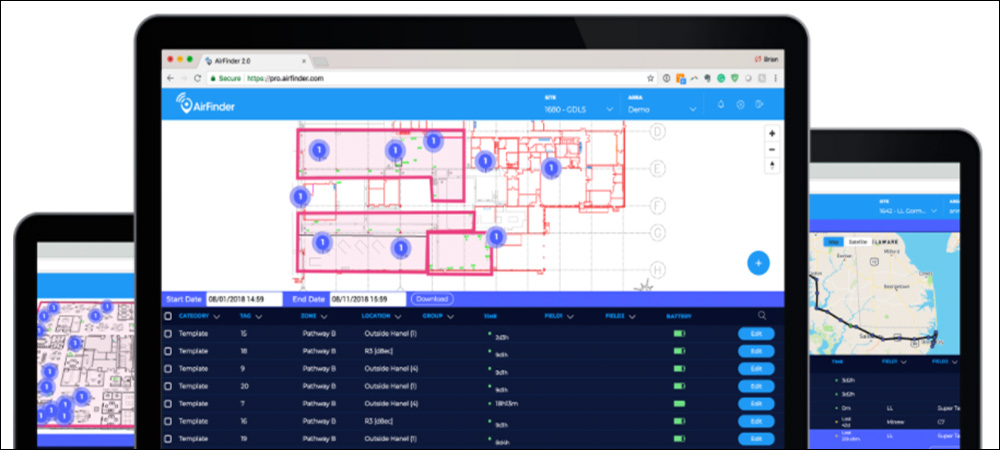
Tag battery life has been extended by approximately one to two years compared to proximity-based location systems, Link Labs notes, without requiring battery replacement. This allows tags with very small batteries to last for up to three years for use cases such as finding assets in large manufacturing or distribution environments. Thus, the company explains, tools, calibrated instruments and other small objects can be tracked effectively.
AirFinder OnSite’s phase-ranging and location-determination process take place on the nRF52833 SOC, requiring less than 1/20th of a second. This allows use cases with low latency requirements to be met, such as forklift tracking or fast alerting as assets leave an internally geofenced area. The AirFinder platform, according to Link Labs, is secure, flexible, software-driven and built for use indoors or outdoors. The solution does not require an internal Wi-Fi system and is capable of operating on its own secure network layer via Link Labs’ Symphony Link or a third-party network layer technology, such as Bluetooth mesh technologies.
According to Link Labs, AirFinder is rapidly deployable and highly scalable, using less infrastructure than other systems, which accelerates IoT deployment time to days instead of months. Location data from each AirFinder device securely flows to a Web-based app or directly to customer databases via extensible APIs, enabling users to locate and monitor assets in real time, as well as analyze asset history, add rules and alerts, and establish geofences. The platform provides remote monitoring and device management, allowing the system to be customized for various use cases.
Semtech, MXC Foundation Announce Open LoRaWAN Networks
Semtech, a supplier of analog and mixed-signal semiconductors and algorithms, has announced that it is collaborating with the MXC Foundation, an organization dedicated to powering IoT advancement on blockchain, as part of its efforts to deploy open networks leveraging the LoRaWAN protocol.
“We are excited to be working together with Semtech to leverage the long-range, low-power and security benefits provided by LoRaWAN networks,” said Xin Hu, the MXC Foundation’s CEO, in a prepared statement. “The combination of blockchain technology and LoRa devices allows us to quickly provision and connect the growing number of crypto miner M2 Pro devices that contribute to the MXC ecosystem. The resulting open blockchain LoRaWAN networks help communities take advantage of various smart-city solutions to maximize efficiency and reduce operating expenses.”
MXC is connecting communities with open-source wireless communication networks in the United States, Europe, Korea and Russia, and it recently reached a strategic smart-city partnership with the government of Hangzhou, China. MXC’s blockchain business model, the company explains, utilizes participants that serve as “supernodes,” deploying and sharing their own personal IoT gateway and producing a massive data highway with extensive LoRaWAN network coverage. Individuals can mine cryptocurrency and improve their own data-transaction exchanges while sharing in MXC’s supernode profits.
“Semtech is dedicated to the development of innovative IoT strategies. With the MXC Foundation’s commitment to using LoRa devices and the LoRaWAN protocol, its mission to deploy open blockchain networks is a success for all stakeholders,” said Marc Pegulu, the VP of IoT product marketing for Semtech’s Wireless and Sensing Products Group, in the prepared statement. “MXC’s model not only incentivizes members to own and operate a piece of its network, but their participation helps reinforce the position of LoRaWAN as the ideal standard of choice for low power wide area networks applications.”

